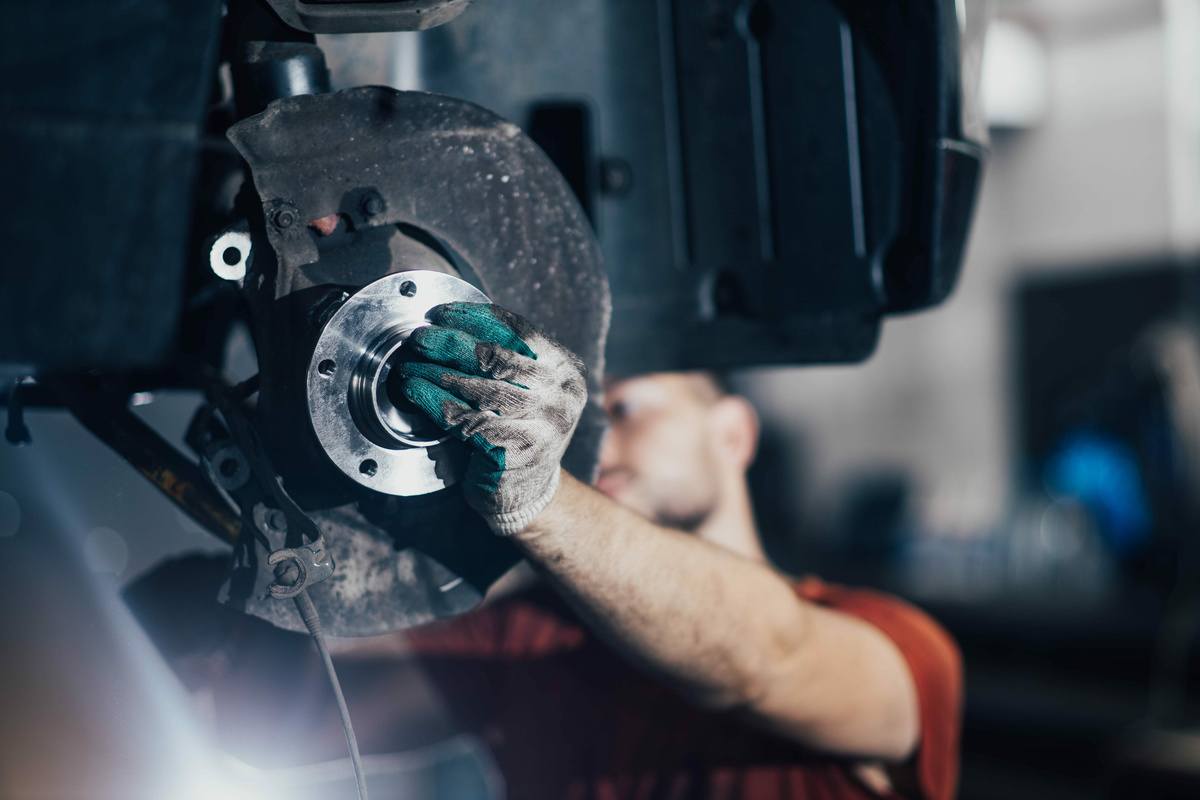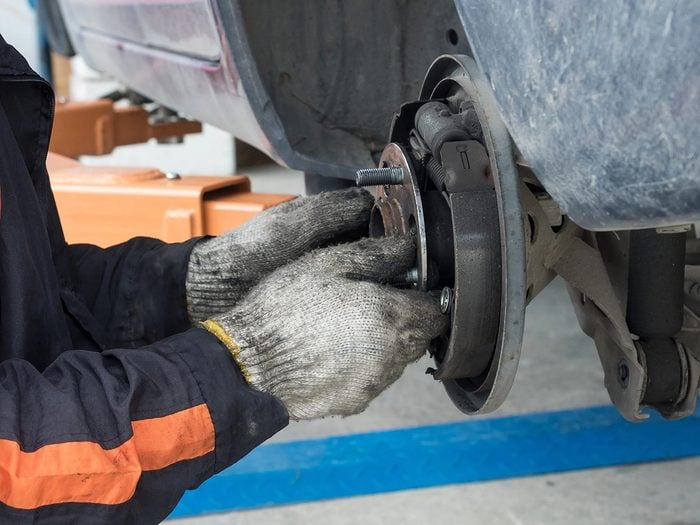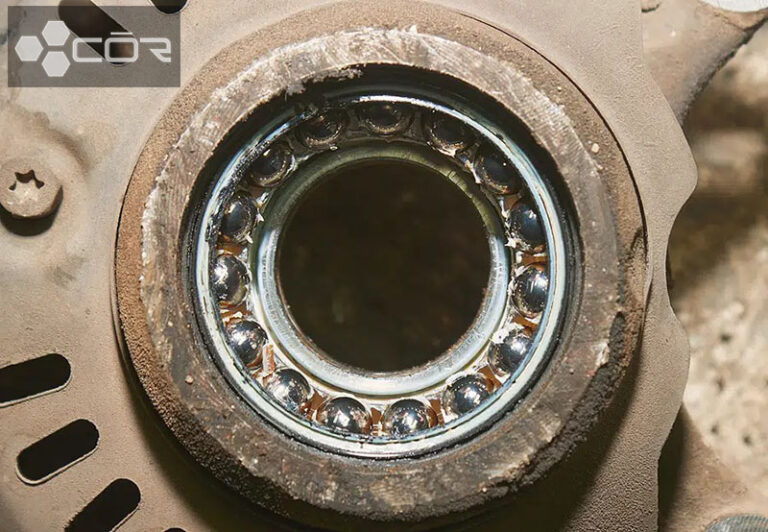Why does a wheel bearing go bad – Why do wheel bearings go bad? It’s a question that plagues many car owners, especially when that dreaded grinding noise starts echoing from the front wheels. These crucial components, hidden beneath the surface, are responsible for keeping your wheels spinning smoothly and safely. But just like any other part of your car, they wear down over time, and eventually, they need to be replaced.
Wheel bearings, like tiny balls of steel within a cage, are designed to reduce friction and allow your wheels to rotate freely. But factors like wear and tear, improper maintenance, and even driving habits can take a toll on these critical components. From the everyday wear and tear of driving on rough roads to the extreme forces exerted during aggressive driving, understanding what can cause wheel bearing failure is key to keeping your car running smoothly and safely.
Wheel Bearing Basics

Wheel bearings are essential components in any vehicle, playing a crucial role in supporting the weight of the vehicle and enabling smooth and efficient rotation of the wheels. They allow the wheels to spin freely while carrying the load of the vehicle, ensuring a comfortable and safe driving experience.
Types of Wheel Bearings
Wheel bearings are classified into two primary types:
- Ball Bearings: These bearings consist of a set of steel balls that rotate between an inner and outer raceway. They are commonly found in older vehicles and are known for their simplicity and affordability.
- Tapered Roller Bearings: These bearings feature tapered rollers that fit between a cone and a cup. They offer greater load-carrying capacity and are more durable than ball bearings. Tapered roller bearings are often found in heavier vehicles, such as trucks and SUVs.
Wheel Bearing Assembly Components
A typical wheel bearing assembly consists of several components that work together to ensure smooth and reliable operation.
- Bearing Races: These are the inner and outer rings that provide a track for the balls or rollers to rotate.
- Balls or Rollers: These elements provide a smooth rolling surface between the races, minimizing friction.
- Cage: The cage or separator keeps the balls or rollers evenly spaced and prevents them from coming into contact with each other.
- Seal: The seal prevents dirt, debris, and water from entering the bearing assembly, which could cause premature wear and failure.
- Grease: The grease lubricates the bearing components, reducing friction and wear.
Common Causes of Wheel Bearing Failure

Wheel bearings are essential components in your vehicle’s suspension system, responsible for supporting the weight of the vehicle and allowing the wheels to rotate smoothly. However, like any mechanical part, they are susceptible to wear and tear, leading to failure over time. Understanding the common causes of wheel bearing failure can help you prevent premature wear and ensure the longevity of your vehicle’s suspension system.
Excessive Weight
Carrying excessive weight puts extra stress on the wheel bearings, accelerating their wear. When a vehicle is overloaded, the bearings are forced to handle more load than they were designed for. This increased load can cause premature wear and tear on the bearing components, leading to premature failure. For example, hauling heavy trailers or frequently carrying large cargo can significantly increase the load on the wheel bearings, making them more prone to failure.
Improper Lubrication
Wheel bearings rely on proper lubrication to reduce friction and prevent premature wear. Insufficient lubrication can lead to increased friction, causing the bearing components to wear down faster. Conversely, excessive lubrication can attract dirt and debris, leading to contamination and accelerated wear. It is essential to use the correct type and amount of grease for your vehicle’s wheel bearings.
Consult your owner’s manual or a qualified mechanic for the recommended lubrication specifications.
Environmental Conditions
Wheel bearings are exposed to harsh environmental conditions, including dirt, water, and extreme temperatures. These conditions can accelerate bearing wear. For example, driving in dusty or muddy environments can lead to contamination of the bearing components, causing friction and wear. Similarly, exposure to extreme temperatures can affect the consistency of the grease, leading to premature breakdown and loss of lubrication.
Driving Habits
Aggressive driving habits, such as frequent hard acceleration, braking, and cornering, can put extra stress on the wheel bearings. These maneuvers can generate high forces that impact the bearings, leading to premature wear and tear. For example, frequently launching from a stoplight with a sudden burst of acceleration can subject the bearings to significant stress. Similarly, aggressive cornering can create lateral forces that can cause the bearings to wear out faster.
Symptoms of a Failing Wheel Bearing
Ignoring the signs of a failing wheel bearing can lead to a dangerous situation. Recognizing the symptoms early on allows for timely repairs, preventing further damage and ensuring your safety on the road.
Common Symptoms of a Failing Wheel Bearing
The most common symptoms of a failing wheel bearing can be categorized as follows:
| Symptom | Description | Examples |
|---|---|---|
| Noise | A rumbling, grinding, or growling sound, especially when turning or driving at higher speeds. | The sound may increase in volume as the bearing deteriorates. It might be more noticeable when turning left or right, indicating a specific wheel bearing is failing. |
| Vibration | A noticeable shaking or vibration in the steering wheel, especially when driving at high speeds. | The vibration might be felt in the floorboard or the entire vehicle. |
| Uneven Tire Wear | Premature wear on one or more tires, particularly on the side where the bearing is failing. | Uneven tire wear can be a sign of a problem with the wheel alignment or suspension, including a failing wheel bearing. |
| Steering Wheel Pull | A tendency for the steering wheel to pull to one side, especially when driving straight. | This symptom is usually accompanied by a noise or vibration, indicating a potential problem with the wheel bearing. |
| Play in the Wheel | Excessive movement or looseness in the wheel when it is rocked back and forth. | You can check for play in the wheel by grabbing the tire at the top and bottom and attempting to move it side to side. |
Sound Progression of a Failing Wheel Bearing
The sounds associated with a failing wheel bearing often change as the bearing deteriorates. This progression can help identify the severity of the issue.
| Stage | Sound Description | Examples |
|---|---|---|
| Early Stage | A faint rumbling or growling sound, usually only noticeable at low speeds or when turning. | The sound may be intermittent and only audible in specific conditions. |
| Intermediate Stage | A more pronounced rumbling or grinding sound, noticeable at higher speeds and even when driving straight. | The sound may become louder and more constant as the bearing deteriorates. |
| Advanced Stage | A loud grinding or roaring sound, accompanied by vibration and possible steering wheel pull. | The bearing may be severely damaged at this stage, requiring immediate replacement. |
Maintenance and Prevention
Just like any other mechanical component, regular maintenance and preventative measures are crucial to ensure the longevity of your wheel bearings. Neglecting these aspects can lead to premature failure and costly repairs.
While wheel bearings are designed to be durable, they are subjected to constant wear and tear, especially under demanding driving conditions. This makes regular inspections and lubrication essential for maintaining their health and extending their lifespan.
Importance of Regular Inspections and Lubrication
Regular inspections and lubrication are critical for identifying potential issues early on and preventing premature failure. This includes:
- Visual Inspection: Check for any signs of damage, cracks, or excessive wear on the bearing raceways, seals, or the surrounding components.
- Grease Inspection: Ensure that the grease is fresh and hasn’t dried out or become contaminated. This is essential for proper lubrication and protection against friction and wear.
- Play Check: Check for any excessive play or movement in the wheel. This indicates that the bearings are worn and need to be replaced.
Proper Lubrication Techniques, Why does a wheel bearing go bad
Proper lubrication is essential for maintaining the health of your wheel bearings. It involves applying the correct type and amount of grease to the bearing components.
- Use the Correct Grease: Choose a high-quality, lithium-based grease specifically designed for wheel bearings. Avoid using multipurpose grease, as it may not provide the necessary lubrication and protection.
- Apply Sufficient Grease: Apply enough grease to fill the bearing cavity and ensure that all the bearing surfaces are adequately lubricated. Over-greasing can cause excessive heat and damage the bearings, while under-greasing can lead to premature wear and tear.
- Pack the Bearings Properly: If repacking the bearings, use a grease gun to pack the bearings with fresh grease. Ensure that the grease is evenly distributed and there are no air pockets.
Role of Alignment and Tire Pressure
Maintaining proper wheel alignment and tire pressure plays a crucial role in ensuring the longevity of your wheel bearings. This is because:
- Wheel Alignment: Improper alignment can cause uneven tire wear and increased stress on the wheel bearings, leading to premature failure.
- Tire Pressure: Incorrect tire pressure can also cause excessive wear and tear on the bearings. Over-inflation can lead to premature wear on the outer raceway, while under-inflation can cause excessive wear on the inner raceway.
Replacement Process: Why Does A Wheel Bearing Go Bad

Replacing a wheel bearing is a relatively straightforward process, but it requires some mechanical aptitude and the right tools. This section Artikels the steps involved in replacing a wheel bearing, along with the necessary tools and safety precautions.
Tools and Equipment
The following tools and equipment are typically required to replace a wheel bearing:
| Tool | Description |
|---|---|
| Jack | To lift the vehicle safely. |
| Jack stands | To support the vehicle securely after lifting. |
| Lug wrench | To remove the wheel nuts. |
| Torque wrench | To tighten the wheel nuts to the correct specifications. |
| Wheel bearing puller | To remove the old wheel bearing. |
| Wheel bearing press | To install the new wheel bearing. |
| Hammer | For tapping components into place. |
| Socket set | For removing and installing various nuts and bolts. |
| Wrench set | For loosening and tightening nuts and bolts. |
| Penetrating fluid | To loosen rusted or seized bolts. |
| Grease | For lubricating the new wheel bearing. |
| Cleaning supplies | To clean the hub and bearing raceway before installation. |
Safety Precautions
Safety is paramount when working on any automotive component, including wheel bearings. Here are some crucial safety precautions to follow:
- Always use a jack and jack stands to support the vehicle securely. Never rely solely on the jack to hold the vehicle.
- Ensure the parking brake is engaged and the vehicle is in park (or first gear for manual transmission). This helps prevent the vehicle from rolling.
- Wear appropriate safety gear, including safety glasses, gloves, and sturdy footwear.
- Use caution when handling sharp tools and be aware of potential pinch points.
- Never work under a vehicle that is only supported by a jack. Always use jack stands for added safety.
- Always tighten wheel nuts to the correct torque specifications. Over-tightening can damage the wheel studs or the hub.
- After replacing the wheel bearing, ensure the wheel is properly aligned. Misalignment can lead to premature tire wear and handling problems.
Steps Involved in Replacing a Wheel Bearing
The steps involved in replacing a wheel bearing may vary slightly depending on the vehicle make and model. However, the general process remains the same.
- Raise and secure the vehicle. Use a jack to lift the vehicle and place jack stands under the frame, ensuring the vehicle is stable and secure.
- Remove the wheel. Use a lug wrench to loosen the wheel nuts while the vehicle is still on the ground. Once loosened, lift the vehicle and remove the wheel.
- Remove the brake caliper. Carefully remove the brake caliper and hang it securely out of the way using a wire or a piece of rope.
- Remove the rotor or drum. Depending on the vehicle, you’ll need to remove the rotor or drum to access the wheel bearing.
- Remove the old wheel bearing. Use a wheel bearing puller to remove the old wheel bearing from the hub.
- Clean the hub and bearing raceway. Thoroughly clean the hub and the bearing raceway to remove any dirt, debris, or rust.
- Install the new wheel bearing. Use a wheel bearing press to install the new wheel bearing into the hub. Ensure the bearing is properly seated and that the raceways are clean.
- Reassemble the components. Reinstall the rotor or drum, brake caliper, and wheel. Tighten the wheel nuts to the correct torque specifications.
- Lower the vehicle. Carefully lower the vehicle and remove the jack stands.
- Test drive the vehicle. After replacing the wheel bearing, test drive the vehicle to ensure the bearing is functioning properly and that there are no noises or vibrations.
Important Note: Replacing a wheel bearing is a complex task that requires specialized tools and knowledge. If you’re not comfortable performing this repair yourself, it’s best to consult a qualified mechanic.
Understanding the causes, symptoms, and maintenance requirements of wheel bearings is essential for any car owner. By recognizing the warning signs of a failing bearing, you can take proactive steps to prevent costly repairs and ensure a smooth and safe driving experience. Regular inspections, proper lubrication, and mindful driving habits all contribute to the longevity of your wheel bearings and the overall health of your vehicle.
Popular Questions
What are the most common signs of a bad wheel bearing?
The most common signs of a bad wheel bearing include a grinding or rumbling noise that gets louder when you turn or accelerate, a vibration in the steering wheel, and a feeling of looseness in the steering.
How often should I have my wheel bearings inspected?
It’s generally recommended to have your wheel bearings inspected every 50,000 miles or as part of your regular car maintenance schedule.
Can I drive with a bad wheel bearing?
It’s not advisable to drive with a bad wheel bearing as it can lead to further damage and potentially cause a safety hazard. The bearing could seize up completely, causing a loss of control over your vehicle.
How much does it cost to replace a wheel bearing?
The cost of replacing a wheel bearing can vary depending on the make and model of your vehicle and the labor costs in your area. However, you can expect to pay anywhere from $200 to $500 for a replacement.